 Signaling
overview
Signaling
overview  How we did it
How we did it  Signaling
on our Modular Layout
Signaling
on our Modular Layout 
HOME CALENDAR OF EVENTS LOCOMOTIVE TYPES SIGNALING DCC MODULAR LAYOUT MEMBERS MEMBERSHIP APPLICATION PRESS COVERAGE OUR HISTORY LAYOUT TOUR FALLEN FLAGS CONSTITUTION
SE8C
& RR&Co  Signaling
overview
Signaling
overview  How we did it
How we did it  Signaling
on our Modular Layout
Signaling
on our Modular Layout 
This page explains the Automatic Block Signal systems in use on former ATSF double track lines operated under Track Warrant Control, denoted as "TWC/ABS/DT" in the timetable. Thanks to BNSF engineer Peter Stronge for his great help in investigating this subject.
Track Warrant Control (TWC) is a way of operating a line without the need of a signaling system. Very simplified, a Track Warrant is a permit for a train to occupy a given section of main track. The dispatcher gives the permission to the train crew via radio. The train crew fills the given permission in a Track Warrant form. The Track Warrant is valid after the conductor has read back the Track Warrant for the dispatcher to check. A Track Warrant is typically a permit saying "Train XXXX, proceed from <location 1> to <location 2>" and whether to stay on the main or take siding at <location 2>. Track Warrants for different trains may not overlap if TWC is the only system ensuring safety on the line.
In Automatic Block Signal (ABS) territory automatic signals are provided to protect trains running in the same direction. This way, trains can safely follow each other as close as the signals allow. Thus, in signaled (ABS) territory, Track Warrants are allowed to overlap for trains traveling in the same direction.
On single track ABS signals are provided for both directions. The dispatcher sets up a direction of running, called "current of traffic", for a section of the line by issuing a Track Warrant to a train. Other trains may now follow according to signal indication. Lines designated DT (Double Track) in the timetable have a track for each direction, normally set for right-hand running. Running trains in the normal direction on a DT track is called running "with the current of traffic" and can be done by signals and overlapping Track Warrants. Lines designated as "ABS/DT" in the timetable have ABS only for trains running with the current of traffic. Running "against the current of traffic" means running without signals and thus on non-overlapping Track Warrants alone. ABS is inadequate by itself because it provides no means of providing limits to the territory in which the train may operate. On the ATSF line described in this document, TWC is superimposed upon ABS to provide such control. In this system, for trains running in the same direction on the same track, Track Warrant territories may overlap, since the ABS signal system provides train separation. Note that TWC supersedes ABS in this arrangement; i.e., the on-paper system carries more authority than the by-signal system.
All in all, this means that as long as trains run in the signaled directions in TWC/ABS/DT territory, the dispatcher can simply issue a Track Warrant for the whole line to each train. In such cases Track Warrants only serve as a means of handling unusual situations like trains having to run "against the current of traffic" i.e. in the unsignaled direction.
The ABS is a fully automatic. There is no remote (human) control of signals or switches and there is no direct supervision of the line. The dispatcher keeps track of the location of trains by instructing the trains to report their positions as necessary.
On the former ATSF, ABS/DT block signals can display 4 signal aspects:
| Signal Aspect | Rule | Name | Indication |
|---|---|---|---|
| 9.50 | Clear | Proceed | |
| 9.54 | Approach Medium | Proceed; approach next signal not exceeding 40 MPH and be prepared to enter diverging route at prescribed speed | |
| 9.56 | Approach | Proceed prepared to stop at next signal, trains exceeding 40 MPH immediately reduce to that speed | |
| 9.61 | Stop then Proceed | Stop, then proceed at restricted speed |
When no trains are present, all signals display Clear. This is the normal state of the block system:

Actually, most signals on double track like this are approach-lit. This means that when no train is approaching the signal the lamps are switched off to increase their lifetime. A signal is switched on only when a train enters the block leading up to the signal. In this document, however, all relevant signals are shown as if they were constantly lit to illustrate the block functions.
In order to ensure sufficient braking distance before a train reaches a signal displaying "Stop and Proceed", the two previous signals will give advance warning, the first by displaying "Approach Medium", flashing yellow on ATSF, the next "Approach", steady yellow:
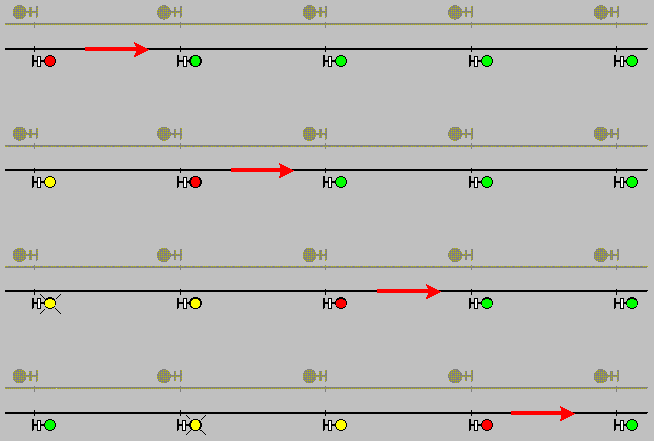
The Needles Subdivision (Barstow - Needles) on the former AT&SF mainline has 145 miles of TWC/ABS/DT between Daggett and Ibis. On such a line, with fairly high traffic density and long grades, it is necessary to have a way of letting trains be overtaken. For this purpose there are numerous sidings along the line. Trains usually get a Track Warrant permitting them to run all the way from Daggett to Ibis, and the dispatcher will instruct trains verbally to enter a siding if they need to be overtaken.
Adding sidings to the line undermines the ABS system's ability to protect following trains unless further action is taken. A train may enter the siding, leaving the main track clear and all signals green, and then pull out of the siding just in front of a train on the main. Here is an illustration of this potential danger:
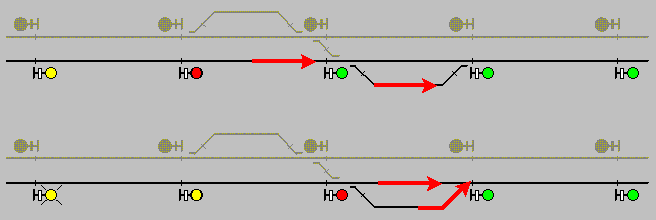
Rules cover this situation by saying that if a train has to leave the siding and enter the main track, the switch to the main track (the siding "exit" switch) must be opened. This action sets the signal protecting the switch to "stop" and sets up signal protection for pulling out of the siding. The crew must wait 5 minutes to see if a train shows up (i.e. a train that was too close when the switch was opened and the protecting signal changed to red). To be able to close the switch for the approaching train the crew must wait at the switch. If no other train can be seen or heard after 5 minutes, the train can pull out of the siding.
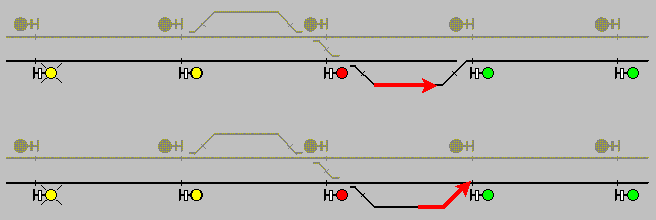
To avoid having to wait 5 minutes after the overtaking train has passed, the former ATSF lines have been equipped with a special "Leave Siding" signal, placed at the end of the siding. The Leave Siding signal tells an engineer of a train in the siding whether it is safe to pull out on the main or not.
As the ABS system is not controlled by a dispatcher, the Leave Siding signal cannot determine whether the train should leave the siding, only if it is safe to do so. Note also that the Leave Siding signal does not tell the engineer if he has the (Track Warrant) authority to leave the siding. It, like the mainline signals, only provides block occupancy indication.
The Leave Siding signal can only display two aspects:
| Signal Aspect | Rule | Name | Indication |
|---|---|---|---|
| 9.56 | Approach | Proceed prepared to stop at next signal, trains exceeding 40 MPH immediately reduce to that speed | |
| 9.62 | Stop | Stop |
An important thing to note is that while block signals on the main track display "Stop and Proceed" as their most restrictive indication, the Leave Siding signal shows "Stop". This way a train in the siding is bound to wait for the signal to clear before pulling out of the siding and thus prevented from pulling out in front of an oncoming train on the main track.
As the next block signal on the main usually is located shortly after the end of the siding, there is no need for the Leave Siding signal to provide advance information for that signal. The Leave Siding signal is normally approach-lit by a track circuit covering the last 400 yds (370 m) of the siding (not shown on drawings). This track circuit has no other purpose. Below is shown an arrangement of sidings for both directions, together with a crossover. The crossover is hand-operated and only used in special situations. Switches designated "S" are spring switches:

The Leave Siding signal protects the block in which the siding ends from a train coming off the siding. If a train on the main is closer than stopping distance from the end of the siding, the Leave Siding signal will display "Stop". In practical terms this means that the Leave Siding signal will display "Stop" if any one of the 3 main block signals (A, B and C below) before the end of the siding displays "Stop". This gives protection even in the worst case, which is: A train on the main passing signal A at "Clear" at the same time as a train pulls out of the siding past signal Cls at "Approach".
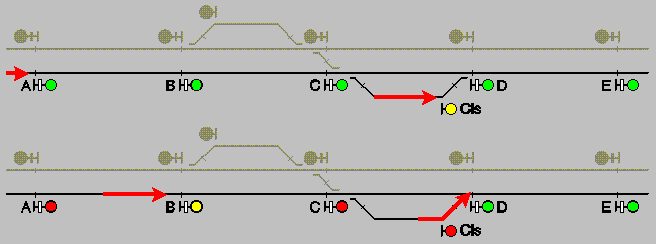
Both trains have acted according to signal indication. As soon as the train from the siding occupies the main, the block signal in the rear (C) will switch to "Stop and Proceed". Signal B will then switch to "Approach", giving the rear train a full block of stopping distance (2 miles) plus the distance from signal C to the end of the siding which is typically at least half a block.
This is how the signals act when a train on the main track runs by a siding:
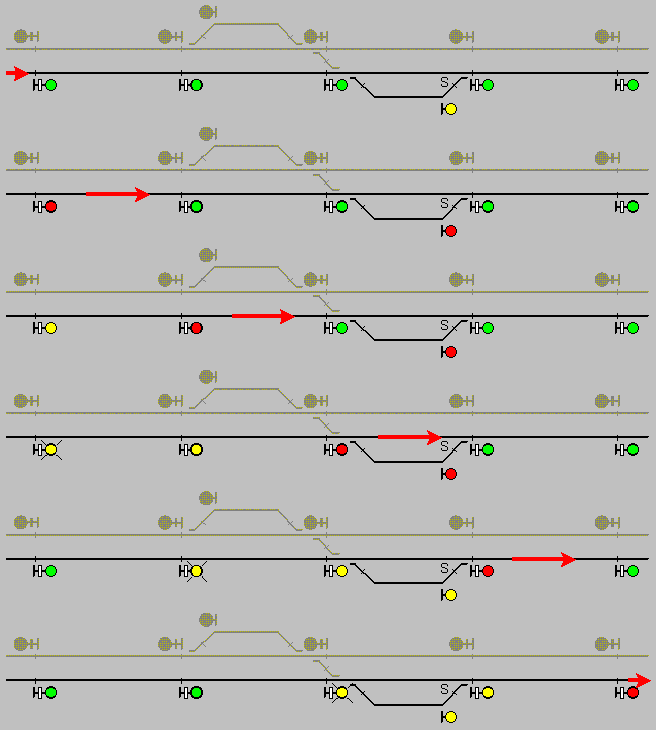
When a train is to be overtaken, it is instructed by the dispatcher to take the siding at location X. The train stops before the entry switch to the siding and the conductor aligns the switch to the siding. Opening the switch sets the protecting signal to "Stop and Proceed" if the train has not already done so by occupying the block. The train then pulls into the siding at restricted speed and stops when the last car is in the siding. The conductor closes the siding entry switch (aligns it to the main track), returning the signals to proceed aspects. The conductor then walks back to the engines.
Previously, when cabooses were still used, the switch would be opened by the front-end brakeman, the train would proceed into the siding, and then the switch would be closed by the rear-end brakeman or conductor riding in the caboose. Since the demise of cabooses, the brakeman or conductor must wait until the train gets into the siding, close the switch, and walk to the front end.
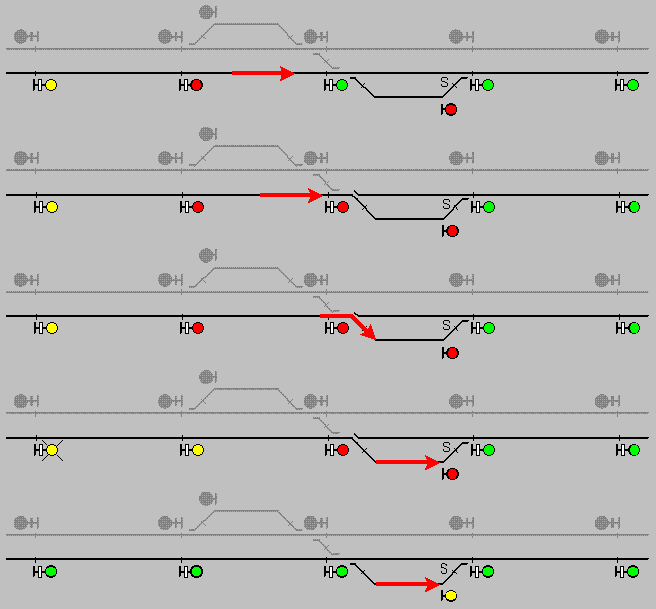
When the overtaking train approaches, the signals will work as sketched before. The ABS system does not need to "know" if there is a train in the siding or not. As soon as the overtaking train has cleared the block where the siding ends, the Leave Siding signal displays "Approach", allowing the train to pull out. The siding exit switch is spring loaded, so the train can just pull out as fast as the switch and track conditions permit.
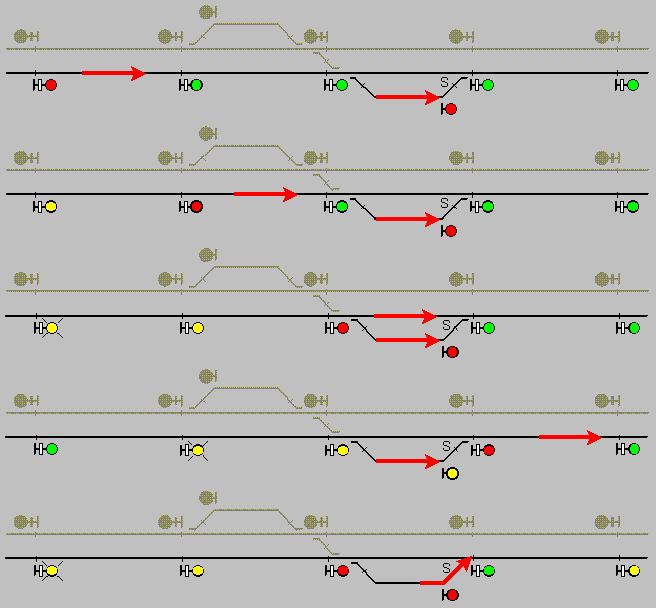
Last Updated: Saturday, August 18, 2018